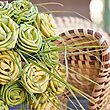Gullah art is a unique form of visual art that is created by artists from the Gullah community, which is primarily located in the coastal regions of South Carolina, Georgia, and Florida. The art is heavily influenced by African and African American artistic traditions, as well as the cultural and natural environment of the Gullah people.
The history of the art can be traced back to the time of slavery, when enslaved Africans used art as a means of communication and cultural expression. During this time, many enslaved Africans used a technique known as “ring shout,” in which they would sing, dance, and create rhythmic patterns while holding hands in a circle. This technique later evolved into other forms of artistic expression, including music, dance, and visual art.
One of the most well-known forms of Gullah art is sweetgrass basket weaving. This traditional craft has been passed down through generations of Gullah women, who use sweetgrass, bulrush, and other natural materials to create intricate and beautiful baskets. These baskets are both functional and decorative, and are highly valued by collectors and art enthusiasts.
Another important form is quilting. Gullah quilts are characterized by their bold, colorful designs and their use of traditional African American patterns, such as the “pineapple” and “flying geese” designs. Gullah quilts often incorporate symbols and images that are important to the Gullah community, such as palm trees, shells, and the ocean.
The art is also represented in other visual art forms, such as painting, sculpture, and mixed media. Many Gullah artists use their art as a means of exploring and expressing their cultural heritage, as well as their personal experiences and perspectives.
Some notable examples include the paintings of Jonathan Green, who is known for his vibrant depictions of Gullah life and culture, and the sculptures of Sam Doyle, who used found materials to create powerful and evocative works of art.
Overall, Gullah art is a rich and diverse artistic tradition that reflects the history, culture, and creativity of the Gullah people. Its use of natural materials, traditional techniques, and cultural symbols has made it an important part of African American artistic history.











